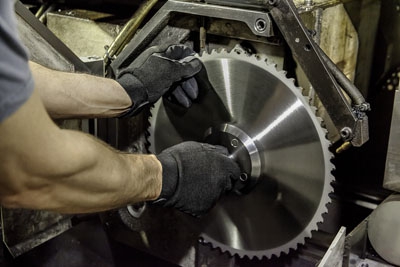
LENOX announces the expansion of the CircTech Precision platform with the newCircTech Precision CM200. LENOX entered the precision circular saw market in 2014 with the launch of the CircTech Precision CM, designed for optimum performance when cutting low carbon steel and mild alloy steels. The second blade in the range, the CircTech Precision CM200, is manufactured for tough alloys and tool steels, materials often required by automotive suppliers, heavy equipment and agricultural equipment companies. The combination of both blades will cover the range of the most commonly-used saws and applications encountered in the industrial precision circular saw market.
"LENOX has made a significant investment to ensure high quality and innovation within the precision circular sawing category," said Matt Howell, senior brand manager at LENOX. "With the launch of the CircTech Precision CM200, we are excited to continue surpassing the needs of our end users as we expand our offering to the market."
The CircTech Precision CM200 offers a number of features that provide users with exceptional blade life, increased cutting rates, and a lower total cost of operations:
• Special grade cermet tips to deliver exceptional heat and wear resistance in the target metals.
• Precision ground teeth that optimize cutting efficiency and durability in order to resist chipping in tough cutting alloys and tool steels.
• Plates that are expertly flattened and tensioned to deliver superior part finish.
Contact Details
Related Glossary Terms
- alloy steels
alloy steels
Steel containing specified quantities of alloying elements (other than carbon and the commonly accepted amounts of manganese, sulfur and phosphorus) added to cause changes in the metal’s mechanical and/or physical properties. Principal alloying elements are nickel, chromium, molybdenum and silicon. Some grades of alloy steels contain one or more of these elements: vanadium, boron, lead and copper.
- alloys
alloys
Substances having metallic properties and being composed of two or more chemical elements of which at least one is a metal.
- circular saw
circular saw
Cutoff machine utilizing a circular blade with serrated teeth. See saw, sawing machine.
- sawing
sawing
Machining operation in which a powered machine, usually equipped with a blade having milled or ground teeth, is used to part material (cutoff) or give it a new shape (contour bandsawing, band machining). Four basic types of sawing operations are: hacksawing (power or manual operation in which the blade moves back and forth through the work, cutting on one of the strokes); cold or circular sawing (a rotating, circular, toothed blade parts the material much as a workshop table saw or radial-arm saw cuts wood); bandsawing (a flexible, toothed blade rides on wheels under tension and is guided through the work); and abrasive sawing (abrasive points attached to a fiber or metal backing part stock, could be considered a grinding operation).
- sawing machine ( saw)
sawing machine ( saw)
Machine designed to use a serrated-tooth blade to cut metal or other material. Comes in a wide variety of styles but takes one of four basic forms: hacksaw (a simple, rugged machine that uses a reciprocating motion to part metal or other material); cold or circular saw (powers a circular blade that cuts structural materials); bandsaw (runs an endless band; the two basic types are cutoff and contour band machines, which cut intricate contours and shapes); and abrasive cutoff saw (similar in appearance to the cold saw, but uses an abrasive disc that rotates at high speeds rather than a blade with serrated teeth).
- tool steels
tool steels
Group of alloy steels which, after proper heat treatment, provide the combination of properties required for cutting tool and die applications. The American Iron and Steel Institute divides tool steels into six major categories: water hardening, shock resisting, cold work, hot work, special purpose and high speed.
- wear resistance
wear resistance
Ability of the tool to withstand stresses that cause it to wear during cutting; an attribute linked to alloy composition, base material, thermal conditions, type of tooling and operation and other variables.






